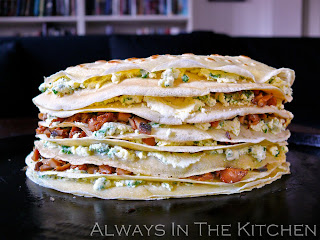
Breads are very satisfying things to make, whether slow-rising yeasted types, batter-style quick breads, or the near instant gratification of the biscuit/scone family. They're a great base for (or addition to) breakfast, the savoury ones pair wonderfully with soups or stews, and any of them can be made into a sandwich or snack with little to no effort. They are infinitely customizable in either sweet or savoury directions.
Coffee shops throughout North America all seem to offer at least one variety, but unless you luck into a place that makes its own (or it happens to be delivery day) you're likely to get something that tastes more of dry flour than whatever the signature ingredient is.
These are tender and not at all dry, and even hold up pretty well at room temperature for a few days, if you can hold out that long.
If you think they look suspiciously like my biscuits - you'd be right. The biggest change is substituting some of the milk for a beaten egg, which is also used to glaze the finished scone. The principals and the principles are otherwise pretty much the same.
Cheese Scones
Makes 8 large, or 16 small
2 cups all purpose flour
4 teaspoons baking powder
1/4 teaspoon Kosher salt
1/2 teaspoon cream of tartar
1 teaspoon sugar
1/3 cup butter
1 large egg, beaten
about 1/2 cup milk
1 1/2 - 2 cups grated tasty cheese (I used sharp cheddar and gouda)
Preheat the oven to 450°F.
In a medium mixing bowl, combine the dry ingredients. Add the grated cheese, or any other additional flavourings (for example, a pinch of cayenne might be nice) at this time. Using a pastry-blender or a fork, or two knives, cut in the butter until the mixture is crumbly and the little lumps of butter are about corn-kernel sized or smaller.
In a small bowl, beat the egg. Reserving 1 tablespoon of the beaten egg in the bowl to use as a glaze later, pour the rest into a liquid-measuring cup. Add just enough milk until you reach the 2/3 cup marker.
Create a well in the middle of the flour mixture and pour the milk/egg in all at once. Hold the bowl steady and, using a fork, stir rapidly but briefly until the dough comes together in a ragged mass. Quickly dump it out onto a clean counter, and knead very lightly and briefly until the flour is incorporated. You may need to add a little extra flour, but probably not. Go cautiously —— too much flour makes the dough tough. It's okay if they're a little sticky. Use a bench knife or dough scraper to lift the dough off the counter as needed.
Pat out the dough into a thick square, and slice into four squares. Cut each of the squares in half diagonally for large scones, and for small scones cut each of the large scones in half again. Try to make sure that your cuts are up and down through the dough —— don't drag the knife sideways out of the dough, or it interferes with them rising later. You can use shaped cutters, of course, if it's important for them to be uniform.
Place the scones on a lightly greased (or silpat) baking sheet, ideally far enough apart that they won't become fused together as they rise. Use a pastry brush to brush the top of each piece with the reserved beaten egg. Be sure to only brush along the tops and not spill down the sides, because that will actually inhibit the scones from rising properly as they bake.
Bake for 12 - 15 minutes, or until they have gotten tall and golden.























